
 (Downtown San
Francisco, taken from the top of the Twin Peaks in the summer of
2011.)
(Downtown San
Francisco, taken from the top of the Twin Peaks in the summer of
2011.)
Hi, I am Zheng, a 5th-year PhD candidate in CyLab Mobility Research
Center, Department of Electrical and Computer Engineering,
Carnegie Mellon University. My research lies in the broad areas
of ubiquitous computing, mobile sensing, and networked embedded
systems. Most of my research projects focus on using machine
learning and signal processing techniques to design and
prototype new technologies for mobile systems. I am advised by
Prof. Pei Zhang
and Prof. Dan Siewiorek.
My resume.
My LinkedIn page.
I will be joining Google as a full-time software engineer starting from the summer of 2014.
Research Projects
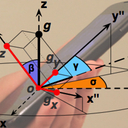
Headio: Zero-Configured
Heading Acquisition for Indoor Mobile Devices Through
Multimodal Context Sensing
Headio
is a novel approach to providing reliable device headings in
indoor environments. It achieves this by aggregating ceiling
images of an indoor environment, and using computer
vision-based pattern detection techniques to provide
directional references. Headio constantly provides accurate
heading detection performance in diverse situations, achieving
better than 1 degree average heading accuracy, up to 33X
improvement over existing techniques that use a digital
magnetometer. [Ubicomp 2013
paper] [Java
Source Code (Open-sourced under the MIT License)]

Spartacus: Spatially-Aware
Interaction for Mobile Devices Through Energy-Efficient Audio
Sensing
Spartacus is
a mobile system that enables spatially-aware device
interactions with zero prior configuration. Using built-in
microphones and speakers on commodity mobile devices,
Spartacus uses a novel acoustic Doppler-effect based technique
to enable users to accurately initiate an interaction with a
neighboring device through a pointing gesture. Experimental
results show that Spartacus achieves an average 90% device
selection accuracy within 3m for most interaction scenarios. [MobiSys 2013
paper] [Introduction
Video (Youtube Link)] [User Gesture Videos &
Analysis Code (Matlab)]
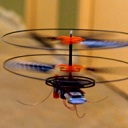 SugarMap: Location-less Coverage
for Micro-Aerial Sensing Swarms
SugarMap: Location-less Coverage
for Micro-Aerial Sensing Swarms
SugarMap is a location-less coverage system that enables
resource-constrained micro-aerial sensing nodes to achieve
efficient sensing coverage. The self-establishing system uses
approximate motion models of mobile nodes in conjunction with
radio signatures from self-deployed stationary anchor nodes to
create a common coverage map. Consequently, the system
coordinates node movements to reduce sensing overlap and
increase the speed and efficiency of coverage. The system uses
particle filters to account for uncertainty in sensors and
actuation of sensing nodes, and incorporates redundancy to
guarantee coverage. Through large-scale simulations and a real
implementation on the SensorFly MAV sensing platform, we show
that SugarMap provides better coverage than the existing
coverage approaches for MAV swarms. [IPSN 2013 paper]
 Polaris: Accurate Indoor
Orientations for Mobile Devices Using Ubiquitous Visual
Patterns on Ceilings
Polaris: Accurate Indoor
Orientations for Mobile Devices Using Ubiquitous Visual
Patterns on Ceilings
Polaris is a system for providing accurate orientations for
mobile phones in indoor environments. It achieves this by
applying computer vision techniques on ceiling images, and uses
constant ceiling patterns of a building as orientation
references. Since ceiling patterns are universal and unrelated
to magnetic fields, Polaris can provide accurate orientations
for mobile devices even under severe magnetic interferences. The
achieved accuracy is lower than 4.5 degree, 3.5X better than raw
compass readings.
(Update 2013: A later improvement leverages online map services
rather than crowd-sourcing to acquire building orientations.
This improvement further increases Polaris' accuracy to lower
than 1.5 degree, capable of supporting numerous ubiquitous and
augmented reality applications. See our Ubicomp 2013 paper.) [HotMobile
2012 paper]
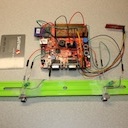
PANDAA:Physical
Arrangement-Detection for Networked Devices through Ambient
Sound Awareness
PANDAA is a zero-configuration spatial localization system for
networked devices based on ambient sound sensing. After initial
placement of the devices, ambient sounds, such as human speech,
music, footsteps, finger snaps, hand claps, or coughs and
sneezes, are used to autonomously resolve the spatial relative
arrangement of devices using trigonometric bounds and successive
approximation. Using only time difference of arrival
measurements as a bound for successive estimations, PANDAA is
able to achieve an average of 0.17 meter accuracy for device
location in the meeting room deployment. Ubicomp
2011 Best Demo Award [Ubicomp 2011 paper][SIGCOMM 2011
demo paper][Ubicomp
slides]
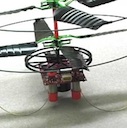
SensorFly: A
Collaboratively-Mobile Aerial Sensor Network
SensorFly is a controlled-mobile aerial sensor network platform
for indoor emergency response application. The miniature,
low-cost sensor platform has capabilities to self deploy,
achieve 3-D sensing, and adapt to node and network disruptions
in harsh environments. In our IPSN paper, we describe hardware
design trade-offs, the software architecture, and the
implementation that enables limited-capability nodes to
collectively achieve application goals. Through the indoor fire
monitoring application scenario we validate that the platform
can achieve coverage and sensing accuracy that matches or
exceeds static sensor networks and provide higher adaptability
and autonomy.
We are currently designing and prototyping the 5th generation of
SensorFly hardware and software. Please stay tuned for an update
of our new platform. Sensys 2009 Best Demo Award [IPSN 2011 paper][video]
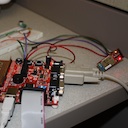
CoughLoc: Location-Aware
Indoor Acoustic Sensing for Non- Intrusive Cough Detection
CoughLoc is a ubiquitous acoustic sensing system for continuous
cough detection using a wireless sensor network. CoughLoc shows
how knowledge of sound source locations can be leveraged to
improve the detection accuracy of sound events caused by mobile
users. Experiments in indoor environments show this system
achieves over 90% cough detection performance under quiet
backgrounds, 1.6 times higher performance compared to a baseline
approach without location information. [MobiSense 2011 paper][slides]
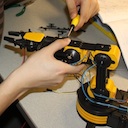
Imirok: Real-Time Imitative
Robotic Arm Control for Home Robot Applications
Training home robots to behave like human can help people with
their daily chores and repetitive tasks. Imirok is a system to
remotely control robotic arms by user motion using low-cost,
off-the-shelf mobile devices and webcam. The motion tracking
algorithm detects user motion in real-time, without classifier
training or predefined action set. I prototyped a robotic arm
with 5 degree-of-freedom. Human gestures are recognized using
motion tracking algorithms in OpenCV. A webcam is used to
capture human gestures, then the inferred gesture sequences are
transferred to a remote control unit (SunSPOT) through 802.15.4
radio, which remotely controls the robot arms.
Experimental results show that the system achieves 90%
precision and recall rate on motion detection with blank
background, and is robust under the change of cluttered
background and user-to-camera distance. [PerCom
2010
paper]
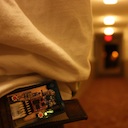
Cortina: Collaborative
Context-aware Indoor Positioning Employing RSS and RToF
Techniques
Cortina is an energy-efficient indoor localization system, which
leverages a wireless sensor network to support navigation and
tracking applications. My colleagues and I developed a hybrid
ranging system, which incorporates both RSS and RToF (round-trip
time of flight)-based techniques.
To overcome indoor multi-path effects, we designed and
implemented algorithms to take into account various context
information. The system was evaluated in an indoor area over
2000 square meters instrumented with twenty-six fixed nodes.
Evaluation results show the system achieved 2.5m accuracy in a
pedestrian tracking application. [PerCom 2010 paper]
Publications
Journal Papers
Zheng Sun, Aveek
Purohit, Philippe De Wagter, Irina Brinster, Chorom Hamm, and
Pei Zhang. “PANDAA: A Physical Arrangement Detection Technique
for Networked Devices through Ambient-Sound Awareness”. In ACM
SIGCOMM Computer Communication Review, Volume 41 Issue 4, August
2011. [pdf]
Zheng Sun, Aveek Purohit, Raja Bose, and Pei Zhang.
“Spartacus: Spatially-Aware Interaction for Mobile Devices
Through Energy-Efficient Audio Sensing”. Invited journal article
at ACM SIGMOBILE Mobile Computing and Communication Review, in
preparation.
Conference and Workshop Papers
Zheng Sun, Shijia Pan,
Yu-Chi Su, and Pei Zhang. “Headio: Zero-Configured Heading
Acquisition for Indoor Mobile Devices Through Multimodal Context
Sensing”. ACM Ubicomp 2013, Zurich, Switzerland, September 2013
(direct acceptance, acceptance rate = 23.4%). [pdf]
Zheng Sun, Aveek
Purohit, Raja Bose, and Pei Zhang. “Spartacus: Spatially-Aware
Interaction for Mobile Devices Through Energy-Efficient Audio
Sensing”. ACM MobiSys 2013, Taipei, Taiwan, June 2013
(acceptance rate = 33/210 = 15.7%). [pdf]
Aveek
Purohit, Zheng Sun, and
Pei Zhang. “SugarMap: Location-less Coverage for Micro-Aerial
Sensing Swarms”. ACM IPSN 2013, Philadelphia PA, April 2013
(IP track, acceptance rate = 24/115 = 20.9%). [pdf]
Aveek Purohit, Zheng Sun, Shijia Pan, and Pei Zhang. “ SugarTrail: Indoor Navigation in Retail Environments without Surveys and Maps”. IEEE SECON 2013, New Orleans, USA, June 2013 (acceptance rate = 51/173 = 29.5%). [pdf]
Zheng Sun, Aveek
Purohit, Shijia Pan, Frank Mokaya, Raja Bose, and Pei Zhang.
“Polaris: Getting Accurate Indoor Orientations for Mobile
Devices Using Ubiquitous Visual Patterns on
Ceilings”. ACM HotMobile 2012, San Diego, CA, February
2012 (acceptance rate = 14/68 = 20.6%). [pdf]
Zheng Sun, Aveek
Purohit, Kaifei Chen, Shijia Pan, Trevor Perring, and Pei Zhang.
“PANDAA: Physical Arrangement Detection of Networked Devices
through Ambient-Sound Awareness”.ACM Ubicomp 2011, Beijing,
China, September 2011. (acceptance rate = 50/302 = 16.6%. Also won Best Demo Award at Ubicomp 2011.) [pdf] [slides]
Zheng Sun, Aveek
Purohit, Kathleen Yang, Neha Pattan, Dan Siewiorek, Asim
Smailagic, Ian Lane, and Pei Zhang. “CoughLoc: Location-Aware
Indoor Acoustic Sensing for Non-Intrusive Cough Detection”.
MobiSense workshop of Pervasive 2011, San Francisco, CA,
June 2011.[pdf] [slides]
Aveek Purohit, Zheng Sun, Frank Mokaya, and
Pei Zhang. 2010. “SensorFly: Controlled-mobile Sensing Platform
for Indoor Emergency Response Applications”. ACM IPSN
2011, Chicago, IL, April 2011. (SPOTS track, acceptance
rate = 9/35 = 25.7%, Also won
Best Demo Award at SenSys 2009.) [pdf]
Zheng Sun, Rick Farley,
Telis Kaleas, Judy Ellis, and Kiran Chikkappa, “Cortina:
Collaborative Context-aware Indoor Positioning Employing RSS and
RToF Techniques”. IEEE PerCom 2011, Seattle, WA, March
2011. [pdf]
Heng-Tze Cheng, Zheng Sun, and Pei Zhang,
“Imirok: Real-Time Imitative Robotic Arm Control for Home Robot
Applications”. IEEE PerCom 2011, Seattle, WA, March
2011. [pdf]
Aveek Purohit, Zheng Sun and Pei
Zhang, “SensorFly: A Collaboratively-Mobile Sensor Network”.
Cylab Partners Conference, Carnegie Mellon University,
Pittsburgh, PA, September 2010.
Zheng Sun, Zhiqiang He,
Ruochen Wang, and Kai Niu, “A Heuristic Scheduling Scheme in
Multiuser OFDMA Networks”, IEEE VTC ’08 Fall, Calgary,
Canada, September, 2008. [pdf]
Ruochen Wang, Zhiqiang
He, Zheng Sun, Shan
Lu, and Kai Niu, “A Revenue-Based Low-Delay and Efficient
Downlink Scheduling Algorithm in OFDMA Systems”, IEEE
VTC ’08 Fall, Calgary, Canada, September, 2008.
Zheng Sun, Wenjun Xu,
Zhiqiang He, and Kai Niu, “Criteria on Utility Designing of
Convex Optimization in FDMA Networks”, the 3rd BWAW workshop
of IEEE ICC 2008, Beijing, China, May,
2008. (Acceptance rate = 16/73 = 21.9%) [pdf]
Zheng Sun, Xiaohong
Huang, and Yan Ma, “Load Balancing Strategies to Solve Flowshop
Scheduling on Parallel Computing”, IC-BNMT 2007, Beijing,
China, September, 2007.
Posters and Demos
Shijia Pan, Yulai Shen, Zheng Sun, Priya Mahajan, Lin Zhang, and Pei Zhang, "Saving Energy in Smart Commercial Buildings through Social Gaming". ACM Ubicomp 2013, Zurich, Switzerland, September, 2013.
Zheng Sun, Aveek Purohit,
Philippe De Wagter, Irina Brinster, Chorom Hamm, and Pei Zhang.
“PANDAA: A Physical Arrangement Detection Technique for
Networked Devices through Ambient-Sound Awareness”. In ACM
SIGCOMM '11.
Zheng Sun, Aveek Purohit,
KathleenYang, Neha Pattan, Dan Siewiorek, Asim Smailagic, Ian
Lane, and Pei Zhang, “VMA: Indoor Acoustic Sensing Platform for
In-home Patient Monitoring”. ACM MobiSys 2010, San
Francisco, CA, June, 2010.
Media Coverage
My research has been featured in the following tech news and reviews.- "Detected", Carnegie Mellon Today Magazine. [online version], Apr 2012.
- "CMUSV Students Win Best Demo Award at Ubicomp ’11", CMU Silicon Valley, Nov 2011.
- “Carnegie Mellon’s flying robots”, CBS SMART-PLANET, May 2011.
- Featured on Sci-Fi Science, Discovery Science Channel, Sep 2010.
- “Swarm Bots”, BBC Focus Magazine, May 2010.
- “Aerobot Invasion”, Popular Science, May 2010.
- “Networked surveillance minicopters can’t be kept down”, New Scientist, Nov 2009.
- “SensorFly robots hunt in packs and can take a battering”, Wired, Nov 2009.
- “Self-righting autonomous swarming robots”, Makezine, Nov 2009.
- “SensorFly survives racket beatdown”, Bot Junkie, Nov 2009.
- “SensorFly Wins Best Demo at SenSys 2009”, Carnegie Mellon CIT Feature, Nov 2009.
- “SensorFly for Hazardous Situations”, Carnegie Mellon Homepage Stories, Aug 2009.
Useful Links
Here is a list of useful links to great people, fun stuff, or
inspiring ideas that I have been collecting over the years.Surviving Ph.D.
PhD Thesis Structure and Content